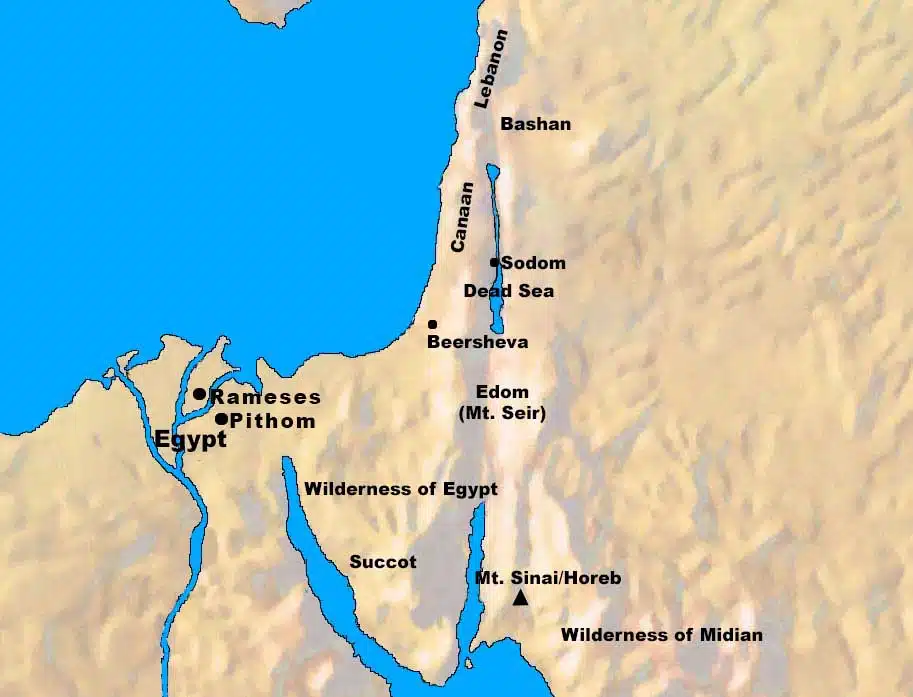Now that the structure of the tabernacle has been specified, the next item discussed is the veil that separates the Holy of Holies from the Holy Place. Both the veil and its supports are described. After the veil was hung, the ark and the mercy seat were to be put in the Holy of Holies, separating them from the other part of the tabernacle. Other furniture was to be located in specific places in the tabernacle.
The veil (Heb. “paroket” meaning “curtain”) was to be made with the same fabric as the curtains that comprise the tabernacle walls.
The same blue and purple and scarlet material (likely dyed wool) woven together along with fine twisted linen were to be used, and it was to have cherubim which were also to be the work of a skillful workman. The cherubim could have been woven in, sewn on, or otherwise adorned.
They were to hang the veil on four pillars of acacia overlaid with gold, their hooks also being of gold, on four sockets of silver. The sockets are probably the bases (or bottoms) of the pillars. These are the same as v. 37, except here they are made of silver, and in v. 37 they are made of bronze, a less precious metal.
The veil needed to be hung under the clasps. Once that was done, they were to bring in the ark of the testimony there within the veil, meaning that it needed to be brought into the Holy of Holies.
The purpose of the veil was to serve for you as a partition between the holy place and the holy of holies. The holy presence of the LORD was to be separated from His people.
They were to put the mercy seat on the ark of the testimony in the holy of holies. The mercy seat was to be a cover over the top of the ark (Exodus 25:17 – 21). The mercy seat was where the high priest would make atonement for the sins of the people (Leviticus 16:15-16).
The other tabernacle items were to be placed outside the veil, outside the Holy of Holies. This part of the tent was called the Holy Place. The table was placed on one side, and the lampstand was positioned opposite the table on the side of the tabernacle toward the south. This resulted in the table being placed on the north side of the Holy Place.
The veil has two types of materials listed. The first is blue and purple and scarlet material. The second is fine twisted linen. Although the material for the first grouping of blue and purple and scarlet is not specified, it is traditionally thought to be dyed wool. The twisted linen would be made of flax, which is a plant fiber that is spun, or twisted to make thread.
The Talmud, which records 1st century Jewish thought, specifies that the blue, purple, and scarlet are dyed woolen threads. A twelfth century rabbi who is one of the most relied upon commentators in Jewish thought, generally known by the acronym “Rashi,” says of this verse: “There are 4 varieties of fiber in each thread. One of flax and three of wool, and each thread was sixfold.” Also, in Hebrew the word “Tekhelet” (translated blue here) is commonly translated by modern rabbis as “blue wool.” This would make sense since the Israelites were sheepherders.
The linen or twisted flax was likely white and not dyed. Linen garments are a common biblical picture of righteousness. It is interesting that later Israelites will be prohibited from wearing wool mixed with linen (Deuteronomy 22:11). Only the holy garments of the high priest and the tabernacle curtains could be manufactured with mixed materials.
Biblical Text:
31 “You shall make a veil of blue and purple and scarlet material and fine twisted linen; it shall be made with cherubim, the work of a skillful workman. 32 You shall hang it on four pillars of acacia overlaid with gold, their hooks also being of gold, on four sockets of silver. 33 You shall hang up the veil under the clasps, and shall bring in the ark of the testimony there within the veil; and the veil shall serve for you as a partition between the holy place and the holy of holies.34 You shall put the mercy seat on the ark of the testimony in the holy of holies. 35 You shall set the table outside the veil, and the lampstand opposite the table on the side of the tabernacle toward the south; and you shall put the table on the north side.
Check out our other commentaries:
-
2 John 1:7-11 meaning
There are liars in the church who teach that Jesus was not both man and God, but merely had the appearance of being a man....... -
Matthew 10:32-33 meaning
Jesus puts His disciples on notice of two contrary truths. The first is that the cost of faithfulness is the scorn and persecution of men,...... -
Exodus 15:22-27 meaning
Verses 22-27 is the first account of a larger section of Exodus describing the three-month journey (19:1) from the Red Sea to Mount Sinai (15:22...... -
Matthew 8:14-17 meaning
Matthew records his third account of a specific miracle. Jesus heals Peter’s mother-in-law of a fever. Later that evening some people bring Him many who...... -
Exodus 29:36-37 meaning
Now that the priests had been purified and set apart for the ministry, the altar was next. Purifying the altar was also to be a......



